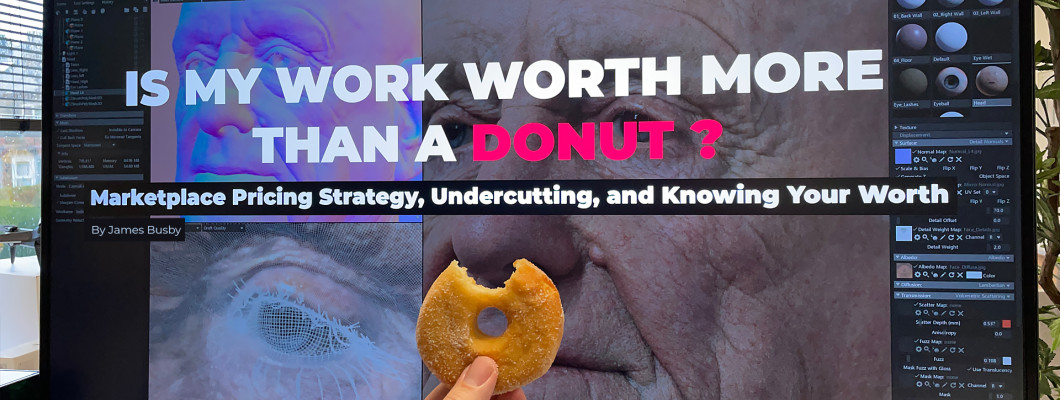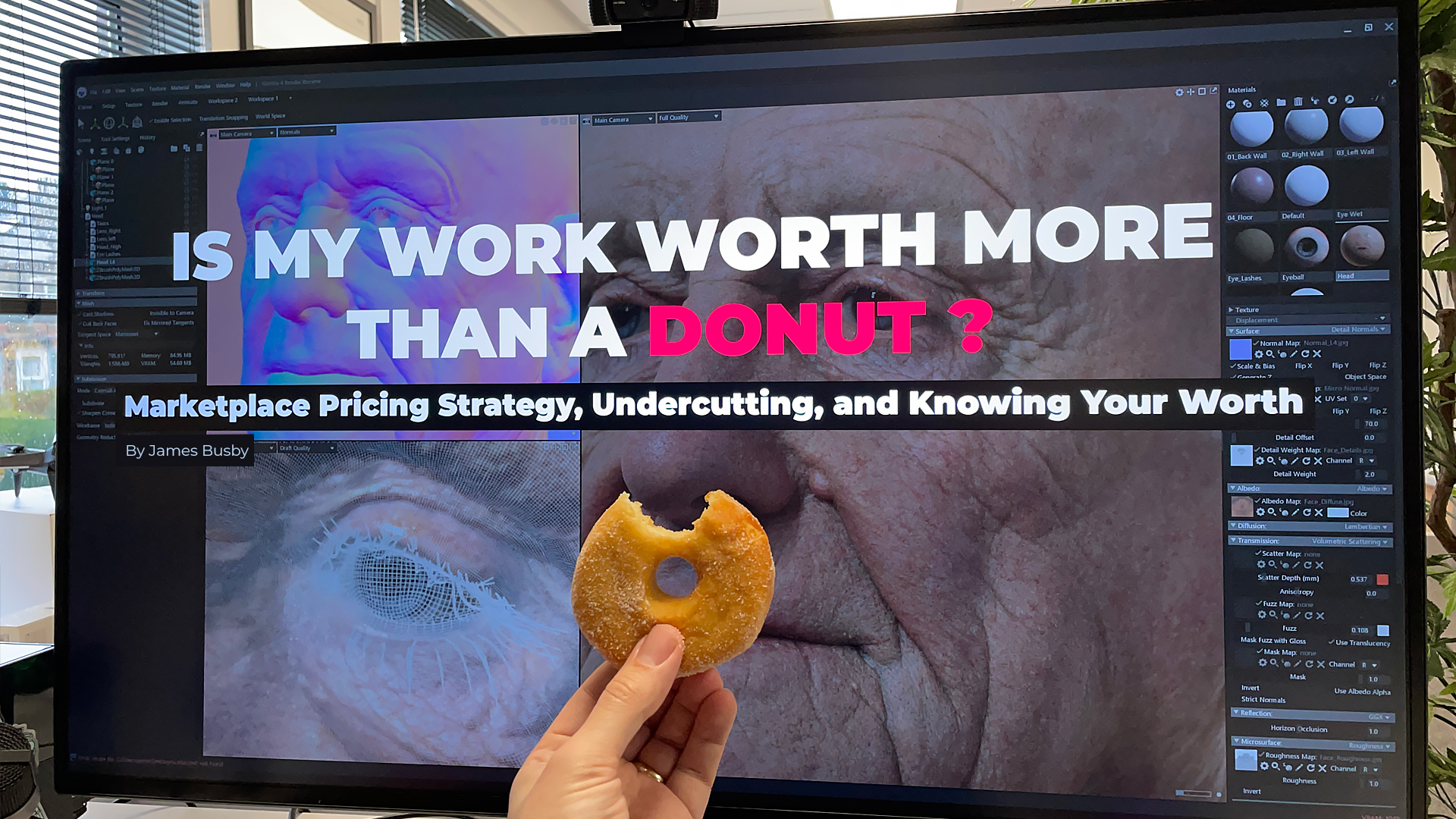
Introduction
Bear with me guys, I’m going on a bit of a rant here but I feel very passionately about this :)
I’ve been in this industry for years and I love it. I genuinely look forward to coming into the office every day, and I work way more hours than I probably should – because I enjoy it so much.
In short, I’m a massive geek.
But there’s one thing about the industry that really annoys me – the persistent and chronic undervaluing of talented artists’ work on digital marketplaces.
How have we got to a point where the work of a highly skilled technical artist is valued at less than the price of a cup of coffee or a donut? Don’t get me wrong, donuts are delicious (especially those little ring donuts you can buy at the British seaside or at theme parks - my favourite). But at the end of the day they’re just a bunch of pretty cheap ingredients fried in oil and coated in delicious delicious sugar.
Think about it: How many hours of learning have you done to reach the level you’re at? 5,000? 10,000? More? How much investment, whether in college fees, tutorials, software purchases, hardware purchases? I’d hazard a guess that the answers are ‘a lot’.
So why is your work priced at, for example, $2.50 on a digital marketplace? Because there’s little to no regulation or moderation on a lot of marketplaces, the pricing is all out of whack – and almost always way, way too low. I can’t stress enough how damaging this is for our industry.
I’m not sure why some artists undervalue their work so much. Maybe it’s lack of confidence, maybe it’s lack of commercial awareness. But whatever the root cause, it sets a dangerous precedent. Other artists see how cheap prices are, and they think they need to follow suit. Before you know it, we have a race to the bottom where no one is a winner. The price of a product should reflect the skill that it takes to create it. Fair enough, there are no tangible materials used to create a digital product. But it’s not something that just anyone can do. It takes ability and experience, and deserves fair compensation.
So given all that I want to talk about about how to price your assets.
What are my 3D assets worth?
Your pricing strategy is an important stage of the whole selling process. Get it right and you’ll maximise sales and profits, and be fairly rewarded for your skill and time. Get it wrong and you risk selling very few assets or making very little profit.
Why should you trust what I'm saying?
I've been selling digital assets for a looooong time. Over 13 years and over over 400,000 models in the last 5 years.
So what's it worth?
Let’s start with some data that we’ve collected over the last 5 years:
The average sale price for a private use license is around £29.99.
The average sale price for a commercial license is around £299.99.
As these are averages, there is quite a wide range of prices within that, so let’s explore in a bit more detail.
One strategy I have found works well when valuing our models is ask ‘how much would I personally be willing to pay for this?’ and then subtract 25%
So let’s look at an example. Imagine you spend over 200 hours creating a super realistic model of a WW2 Tank. How much should you be charging for this both for personal and commercial licenses?
Personal License perspective:
Firstly, consider what someone who’s buying a personal license is going to use that asset for. It is likely that they’ll use it to study, render, put in a portfolio piece to show off their lighting skills, or maybe to modify for their own personal project. With that in mind, it’s very unlikely that they would be willing to spend thousands of pounds.
One mistake you may be tempted to make in this instance is to think that because you spent 200 hours (25 days) and you normally get paid, for example, £20 an hour that the model is then worth £4000. That logic would only apply if you were planning to only sell one model as a bespoke project.
Ask yourself how much you would be willing to pay for a nice tank model if you needed one for a personal project. Personally I would say around £120. Using the -25% rule, £120 less 25% becomes £90 which seems fair to me. I’d happily pay £90 to avoid the 100's of hours of work required to build that model. Because I’m buying the model for convenience (time saving) and not commercial gain, anything much more than that is probably going to put me off.
Commercial License perspective
In this case you should ask yourself how much a studio would be prepared to pay for a model that will save them over 200 hours of work?
Let’s look at what it would cost a studio to produce the same WW2 tank.
Let's assume the average artist's wage is between £30000 - £60000 GBP which equates to roughly £14 - £29 per hour, for the sake of argument lets take a figure in the middle: £21 per hour
200 x £21 is £4,200.
So does this mean your model is worth £4,200? Unfortunately no, it’s not quite as simple as that.
You will very likely sell more than 1 of these models. In fact, if it is a good, sought after model you should anticipate between 5 – 30 commercial sales per year.
Because studios know that this product will not be unique to them, its value of course decreases somewhat.
So what’s a sensible price? What I tend to do in these situations is review the model in terms of its usefulness.
Look at your model objectively and ask yourself: how useful is the model on a scale of 1 – 10? With 1 being not useful at all (very niche with a limited target market) and 10 being a high quality, hard to produce, time saver model with broad appeal, such as a collection of highly realistic human heads.
So where would the WW2 tank fall on this scale? I would say around a 3, as there are not a lot of studios making games that will require that specific tank. So with this in mind we can use a sliding scale based on our notion of usefulness, and deduct a portion of the estimated value accordingly:
1 – deduct 80% of the cost to produce
2- 75%
3- 70%
4- 65%
5- 60%
6- 55%
7- 50%
8- 45%
9- 40%
10 – deduct 35% the cost to produce
So let’s use this scale to work out the price of our tank. £4,200 perceived value, with a usefulness rating of 3, so we deduct 70%. This gives us a commercial license price of £1,260 which seems fair. If you price the tank model much higher than that, studios may instead opt to hire an artist to create something similar.
The best approach is to make products that people want – assets that would score well on the useful index – and price them fairly.
Undercutting and price wars
It’s very common these days to see certain sites selling highly valuable digital assets for next to nothing - sometimes in the region of a few dollars. The thinking behind this is two fold, 1) If I make it cheap I will sell lots, 2) If I make it cheaper than my competitor's customers will buy my model rather than theirs.
Both these assumptions are flawed. Let’s address the first point.
Sell cheap sell lots?
Again, I can’t stress to you how dangerous this is to our industry. If buyers start to believe that 3D models and other high quality digital assets are next to worthless this devalues our entire industry. Please don't fall foul of this trap, your work is worth more than other sites would have you believe. Know your worth – you deserve to be paid fairly for your skills and your time.
But does keeping the price low mean you will sell more models? Well, it may, providing it has relatively broad appeal. But – crucially - does it mean you will get paid more than if you priced them sensibly? Not necessarily.
Let’s take a real life example based on a product we have personally experimented with on our site.
This product was initially valued at £25. As an experiment, we reduced the price significantly to £5 for a period of 2 months. During those 2 months we sold 155 of those models generating income of £775.
After the product was returned to its normal price of £25, in 2 months we sold only 53 – so the sales units dropped significantly - but we made £1,325, nearly double the income. The reason being the model was worth £25 and people were willing to pay that much for it. It’s about finding the sweet spot by understanding what your asset is worth.
If I undercut my rivals people will buy my models instead of theirs, won’t they?
This really only applies if you are producing exactly the same asset as your competitor - and I mean identical - which is very rare in our industry.
Most customers who visit market places will do so with a specific item in mind. If your asset doesn’t fit the bill, it doesn’t matter how cheap it is, they will still not choose it over the product that is exactly what they want.
If your assets really are very similar to another sellers’, consider price matching rather than undercutting; undercutting can very quickly become a race to the bottom: you drop your price, the other seller drops their price even further – before you know it, neither of you is being paid what you’re worth.
However be wary when price matching: if you think the product you’re price matching to is too cheap, then it probably is, so set your own price accordingly – you may inspire the other seller to price match you. Remember, know your worth and price your products fairly.
Peace out
Jamie

